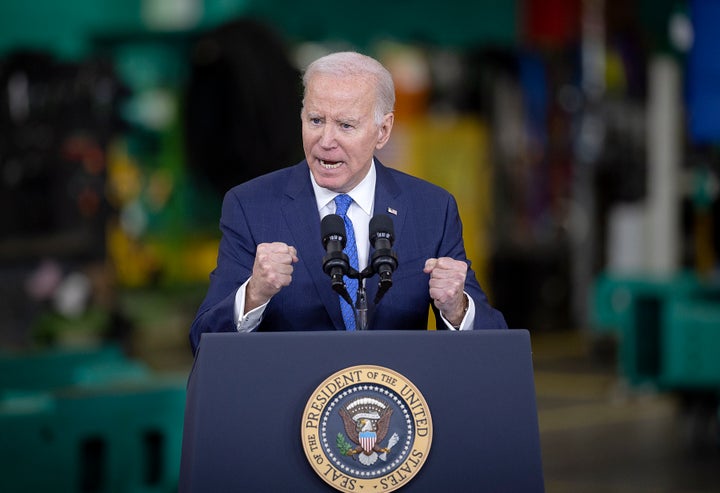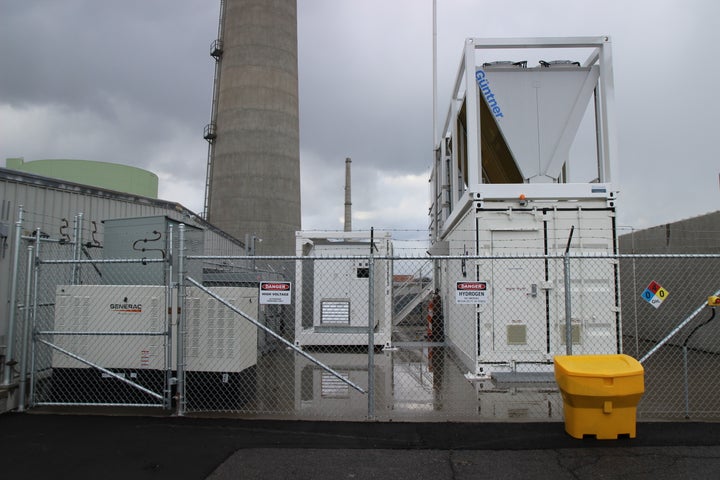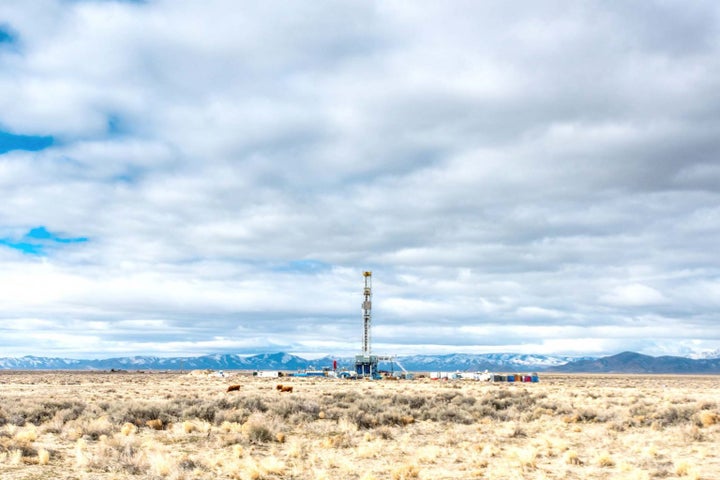
The Biden administration sided with Senate climate hawks in one of the highest-stakes debates over the future of U.S. efforts to cut planet-heating emissions, announcing its long-awaited proposal on Friday for strict rules on production of the hydrogen fuel the federal government is betting on to replace natural gas and oil.
When burned, the only byproduct from hydrogen is water. But nearly all the hydrogen on the market today is made with natural gas through a chemical process that leaves behind climate-changing pollution. Another method of making hydrogen by zapping water with electricity costs more and generates less. But if that power comes from a zero-carbon source, the resulting fuel is considered among the best emissions-free alternatives to jet fuel, diesel and coal in steelmaking.
To bring down the cost of clean hydrogen, the landmark climate-spending law President Joe Biden signed last year, the Inflation Reduction Act, earmarked hundreds of millions of dollars for companies that generate the fuel using clean electricity to claim as write-offs on federal tax bills.
But debate has raged since ― both among Democrats who wrote the legislation, and within the industries that want to make money off clean hydrogen ― over how the government should decide whether electricity is clean. No money can go out until the question is settled. On the Friday morning before Christmas, the Treasury Department provided its answer in a lengthy proposal now subject to 60 days of public comment.
It’s about much more than just hydrogen.
For the first time in more than half a century, the federal government is charting course for swift changes to American industry and infrastructure in the name of larger societal goals. Spurred on by a sense of global competition with China, the U.S. in just three years enacted three major new laws directing the equivalent of a mid-sized nation’s gross domestic product in spending toward rebuilding U.S. manufacturing, particularly of microchips and energy technologies. Future U.S. government efforts to remove carbon dioxide emissions from the atmosphere or incentivize new industries will likely follow the example the hydrogen program sets.
The most controversial issue centered on whether hydrogen is only clean if the producer helped bring enough new green power to the grid to offset the additional demand from electrolyzers ― the machines that use electricity to separate the H from H20.
Opponents said it takes so long to build anything in the U.S. that a strict requirement for new electricity supply would smother the country’s nascent hydrogen industry, allowing the fossil-fueled incumbent to retain its control of the market. Nuclear power companies in particular balked at a requirement the world’s largest but fast-shrinking atomic energy fleet could hardly meet, given that building a new reactor can take a decade or more. Nearly a dozen Democrats who co-authored the Inflation Reduction Act in the first place warned that regulations mandating new supply would clash with their intentions in writing the law.
But supporters of requiring new supply ― including environmentalists and the world’s largest hydrogen manufacturer ― said it was the only way to ensure that a green hydrogen boom didn’t simply shift emissions around the economy.
Worse yet, hydrogen coming off a dirty grid was actually generating more emissions than the same volume of the fuel made the traditional fossil-fueled way. Electricity is lost extracting the hydrogen from the water, so the total amount of energy contained in all the hydrogen produced from an electrolyzer is less than what was used to make it. If new clean supply isn’t required, Democrats like Sen. Sheldon Whitehouse (R.I.) argued, then this policy they wrote to finance the creation of a clean industry would actually just cannibalize existing green electricity and fund a fossil-fuel bacchanal.
Whitehouse’s side won over the White House.
Three senior administration officials on a call with reporters Thursday morning stressed repeatedly the proposal is not final, and pointed out that the regulatory notice specifically requests comments on ways to help existing nuclear plants qualify for the tax credit.
But Department of Energy data show even the patches of the U.S. grid system with the most atomic energy stations aren’t clean enough on the whole to strike the requirement for new supply, they said.

So the plan as of now is to require companies seeking to claim one of the IRA’s so-called 45V tax credits for producing clean hydrogen with electrolyzers plugged into the grid, to submit documentation from an accredited third-party certification service showing that each kilogram of hydrogen was made with electricity that checks three boxes.
The first is that the electrolyzer facility was located near a source of clean electricity. The second is that the facility was generating the hydrogen at a time when there was plenty of clean electricity on the grid. The third ― and most controversial ― is that new, clean supply entered service on the grid to offset the electrolyzer’s demand.
The European Union enacted similar rules for its own hydrogen subsidies. But the law worked differently in Europe, and allowed for a specific carveout the French government demanded for nuclear energy.
Utility giant Constellation, the largest nuclear plant operator in the U.S., said the third “additionality” requirement in the U.S. government program unfairly cuts out atomic energy, and sends a confusing signal. The president’s Bipartisan Infrastructure Law, which passed before the IRA, directed billions of dollars toward setting up eight hydrogen industrial clusters across the U.S., three of which include nuclear companies. Constellation has what it called the world’s first commercial nuclear-powered hydrogen operation going in Oswego, New York, funded jointly with the Energy Department. Now those projects are in jeopardy, the company said, encouraged through one law and discouraged by another.
“The proposed rule flies in the face of Congress’ clear intent to use America’s nuclear energy to produce hydrogen,” Constellation said in a statement emailed to HuffPost. “If finalized, America will surrender hydrogen and deep decarbonization leadership to China and Europe, both of which have policies that smartly utilize their existing nuclear plants to make hydrogen and speed decarbonization.”
The administration officials ― who declined to speak on the record ― said Thursday that Energy Department analysis found that about 5% of the existing nuclear fleet is at risk of retiring early, despite all the other incentives for atomic energy that were enacted in other parts of the IRA and in state laws. That “would or could suggest” that establishing some kind of 5% “allowance” for existing generation on the grid “would be appropriate,” one official said, noting that “this is why we need feedback from industry during the 60-day period.”
But enacting the rules as proposed would deliver a big win for another, nascent form of zero-carbon electricity that, like nuclear reactors, pumps out power 24 hours a day, unlike weather dependent solar and wind energy. Geothermal power, which harnesses the heat from the Earth’s core to make steam for electricity, exists at only a few commercial operations in the U.S. right now.

But the Houston-based Fervo Energy just broke ground on an “enhanced” geothermal plant in Utah that could set the stage for what executive Ben Serrurier called a “revolution.” Drilling technology once limited geothermal energy only to places where there was enough volcanic activity, seismic vents or shallow enough crust to reach the tap of the Earth’s heat for making steam. Borrowing the “fracking” technologies that transformed the U.S. into the world’s No. 1 producer of oil and gas, Fervo can drill down to heat virtually anywhere in the world, using the financing models, workforces and technologies that worked well in fossil fuels, vastly expanding the potential for geothermal energy. Its first power plants are expected to come online by 2028, the same year the rules for the tax credits propose to take full effect.
Hydrogen producers will need zero-carbon electricity 24 hours a day to get the most out of the tax credit.
“At Fervo, we’re really excited about the prospect of stringent 45V [rules],” said Serrurier, who leads government relations and policy for the company. “What we’re doing with geothermal is really well set up to serve that need, and we’re super excited about partnering with companies to figure out how to integrate hydrogen and geothermal production.”
Nowhere in the U.S. is geothermal power currently producing hydrogen. That’s in part because Fervo announced a major breakthrough in its “enhanced” geothermal technology just this past summer. The milestone was unexpected. The climate-spending laws written in 2021 and 2022 did not account for the possibility of enhanced geothermal resources coming even faster than some of the advanced nuclear energy technologies the legislation subsidizes.

But geothermal offers not only the same benefit of constant, zero-carbon power that nuclear provides, it also generates huge amounts of steam, like atomic energy, which can be used for novel methods of producing hydrogen that promise to generate the fuel even more efficiently than the electrolyzers on the market today.
Sticking to the strict rules the Biden administration proposed Friday would make it easier for companies like Fervo to begin attracting private investors who might see the lack of government subsidies tailored specifically to geothermal as a risk.
So far, the company’s timing hasn’t been right.
Federal and state agencies have poured billions into offshore wind turbines and small modular reactors the nuclear industry is banking its future on, despite mounting cost overruns and developers canceling major projects. The president’s Bipartisan Infrastructure Law made just $20 million available for help funding research on geothermal drilling. California regulators’ order in 2021 that utilities procure more geothermal was a game changer in terms of government support for the energy source.
“We feel like we’re jumping up and down raising our hands here,” Serrurier said. “Our technology matured two years too late to get into the IRA. It’s easily overlooked. But that’s going to surprise a lot of folks.”
But now, he said, Fervo is in the process of commercializing a first-of-its-kind technology, so competing in the hydrogen space hasn’t been a priority. The guarantee of a stringent rule that, in five years, will kick in fully, means its plants could come online in 2028 and bank on a hydrogen payday.
“Next-generation geothermal missed out before due to some timing issues,” Serrurier said. “It has not received anywhere close to the deployment support other technologies have.”
“Our technology matured two years too late to get into the IRA. It’s easily overlooked. But that’s going to surprise a lot of folks.”
- Ben Serrurier, Fervo Energy
Fervo said it was lobbying the Biden administration to write up a rulebook for geothermal companies to use tax credits under the IRA, which would make it easier for the company to show investors it can benefit from the law’s clean energy incentives.
But relying entirely on power plants just now going through the lengthy process of lining up investors, picking a location, winning over locals and securing permits ― much less a new technology still unproven at scale like geothermal ― “will make many clean hydrogen projects uneconomic and will create years of delay for the few projects that can move forward in the face of the Administration’s added constraints,” the Nuclear Energy Institute said in a statement. The industry group called the proposal “a major step back” on the climate progress the IRA heralded.
Other companies are moving forward with projects that comply with the strict rules. Air Products and Chemicals Inc., the largest commercial supplier of hydrogen fuel in the world, is building a $4 billion megaproject in Texas to generate green hydrogen with all-new wind turbines and solar panels.
“We urge you to be skeptical of claims that proposed strong guidance will kill the industry,” Air Products and six other hydrogen companies with a combined market value of nearly $100 billion wrote in a letter to regulators. “This is demonstrably false.”
Constellation did not say whether it would make good on its previous promise to sue the administration over the rule, but the company warned that excluding atomic fission from the American hydrogen mix right as the energy source is taking off would just put U.S. industry at a disadvantage in the global race.
“The U.S. invented nuclear energy, but policies like this turn our collective back on the hundreds of thousands of women and men working 24/7/365 to produce clean, reliable energy,” the company said, “and in an ironic twist, the rules claim that existing nuclear, ignored for years, is now simply too valuable to use for hydrogen production.
Sen. Joe Manchin (D-W.Va.), the powerful head of the Senate’s energy committee and the vocal opponent of strict new supply rules, said last week the administration’s proposal was “horrible” and opened the door to joining any litigation challenging the regulation. But the senior officials said the administration was confident that the new supply regulation would comply with both the IRA and the Clean Air Act.
Asked about the pushback from fellow Democrats on Thursday’s call, the senior officials urged critics to read the fine details of what they called a complex proposal ― with an apparent emphasis on the second word.
